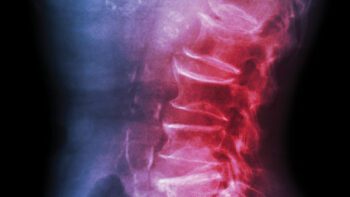By Saman Shabani, MD, Medical College of Wisconsin

FUSION DETAILS
Traditionally, degenerative disc disease of the cervical spine (neck) that causes radiating arm symptoms (cervical radiculopathy) or symptoms associated with spinal cord impingement (myelopathy) is treated with anterior cervical discectomy and fusion (ACDF). The goal of ACDF is not only to remove the pressure from the nerve roots and/or spinal cord, but also to form a bony fusion across the discectomy site. This procedure usually involves:
- complete discectomy to remove pressure on the nerve roots and/or spinal cord
- placement of a spacer to fill the discectomy site
- placement of a plate with screws across the discectomy site
- packing the spacer with bone graft
Placement of the spacer and plating with screws and ultimately formation of bony growth (fusion) will result in a loss of motion across that segment where the discectomy is performed. This leads to higher stress levels across the unfused segments of the spine and may accelerate the degenerative process at those segments. When this occurs, patients may require additional surgery to address the faster degenerative process stemming from the original ACDF.
CERVICAL DISC REPLACEMENT DETAILS
In the last decade, anterior cervical disc replacement (ACDR), also known as cervical arthroplasty, was introduced as an alternative procedure to ACDF. The goal of ACDR is to relieve the pressure from nerve roots and/or spinal cord while preserving the motion across the discectomy site. The procedure involves discectomy and placement of a motion-preserving implant. The preservation of motion reduces the stress load at the levels above and below the discectomy site, preventing the accelerated degenerative process seen in ACDF.
OTHER CONSIDERATIONS
Anterior cervical disc replacement has other advantages compared to ACDF. Although both have quick recovery times, patients with ACDR can return to more strenuous activities sooner than ACDF. In ACDF, a longer period of recovery is needed for fusion to occur.
Not every patient will be an ideal candidate for ACDR. Currently the Food and Drug Administration (FDA) has approved ACDR for up to 2 disc levels. Usually, ACDR is performed on individuals who are younger and do not have:
- facet joint degeneration
- poor bone quality (osteoporosis)
- underlying instability
- spondyloarthropathies
- infection
- known malignancy
Overall, both ACDR and ACDF are very effective surgeries, but patient selection for the appropriate surgery is essential for a successful outcome. This highlights the importance of a good patient-surgeon relationship to discuss these options and the evidence behind them.
You can find more articles like this one on cervical disc replacement or fusion in our Spine Health Journal.
REFERENCES
- Findlay C, Ayis S, Demetriades AK. Total disc replacement versus anterior cervical discectomy and fusion: a systematic review with meta-analysis of data from a total of 3160 patients across 14 randomized controlled trials with both short- and medium- to long-term outcomes. Bone Joint J. 2018 Aug;100-B(8):991-1001. doi: 10.1302/0301-620X.100B8.BJJ-2018-0120.R1. PMID: 30062947.
- Loidolt T, Kurra S, Riew KD, Levi AD, Florman J, Lavelle WF. Comparison of adverse events between cervical disc arthroplasty and anterior cervical discectomy and fusion: a 10-year follow-up. Spine J. 2021 Feb;21(2):253-264. doi: 10.1016/j.spinee.2020.10.013. Epub 2020 Oct 17. PMID: 33080376.
- Robertson JT, Papadopoulos SM, Traynelis VC. Assessment of adjacent-segment disease in patients treated with cervical fusion or arthroplasty: a prospective 2-year study. J Neurosurg Spine. 2005 Dec;3(6):417-23. doi: 10.3171/spi.2005.3.6.0417. PMID: 16381202.



